
- SAP CRM – Home
- SAP CRM – Introduction
- SAP CRM – Architecture
- SAP CRM – Capabilities
- SAP CRM – Integration With SAP SD
- SAP CRM – GUI
- SAP CRM – WebClient UI
- SAP CRM – Web UI Configuration
- SAP CRM – Sales
- SAP CRM – Account Planning
- SAP CRM – Activity Management
- SAP CRM – Opportunity Management
- Quotation & Order Mngmt
- SAP CRM – Outline Agreements
- SAP CRM – Taxes
- SAP CRM – Marketing
- SAP CRM – Marketing Planning
- SAP CRM – Marketing Calendar
- SAP CRM – Campaign Management
- SAP CRM – Service
- SAP CRM – Service Request Mngmt
- SAP CRM – Service Contracts
- SAP CRM – Service Order Mngmt
- SAP CRM – Interaction Center
- SAP CRM – IC Profiles & Configuration
- SAP CRM – Product Master
- SAP CRM – Business Transactions
- SAP CRM – Pricing
- SAP CRM – Billing
- SAP CRM – Web Channel
SAP CRM - WebClient UI
SAP GUI is used to perform administration tasks in SAP CRM. To perform customization and configuration of CRM activities, a client tool is recommended by SAP which is known as SAP CRM WebClient User Interface.
How to Login to SAP CRM WebClient?
You can login to SAP CRM WebClient via SAP GUI. To open the login window, you can use the following transaction code −
T-Code: CRM_UI and press Enter.
If nothing happens, it shows that you are using an older version of SAP CRM.
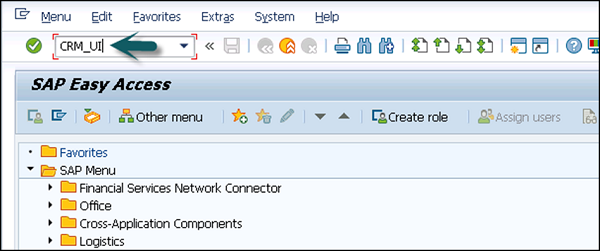
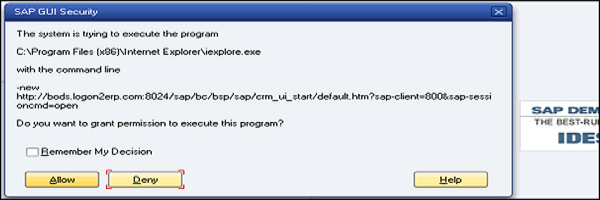
Once you click allow, you will see the following screen with login details.
Use Transaction code: BSP_WD_CMPWB and enter the name in the Component field and click Execute.
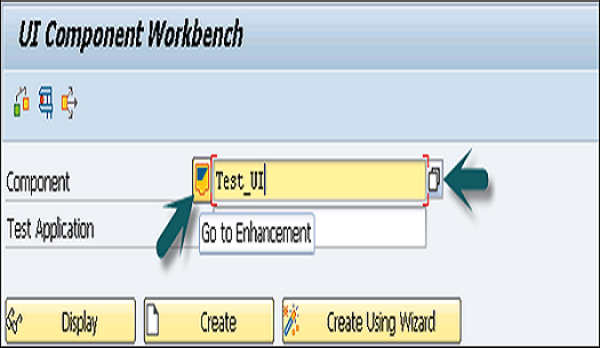
When you click Execute, you will see the login screen of CRM WebClient UI. Enter the user name and password to login.
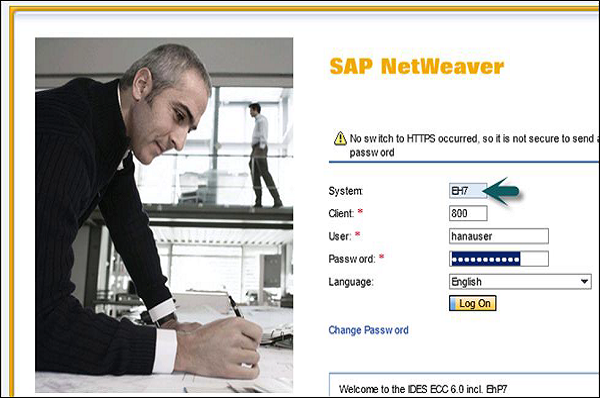
WebClient UI Components
This SAP CRM WebClient is used to access only those applications for which a user role is assigned and have the authorization. In case there is a user with a single role added to his profile he/she can only login with that role and does not get an option to select the role on the login page.
When there are multiple roles assigned to a user, he/she can select one of the available roles in order to log-in to the CRM Web UI.
SAP CRM WebClient is divided into three parts, which are −
- Navigation bar
- Header Area
- Work Area
The entire frame in UI WebClient is known as the Navigation bar. You can navigate to different pages in this Navigation bar. The Header area is at the top and contains the system links, work area title, saved searches, history, etc.
The Work area is a place where changes happen with user actions and where user works. The work area also contains work center groups, overview pages, email inbox, etc.
The following is a list of all the components in a SAP CRM WebClient UI −
- Header and Navigation bar
- Home page
- Work center page
- Search page
- Overview page
- Edit page
- Edit list page
- Search help dialog box
- Value help dialog box
- Personalization dialog box
- Freestyle application page
Header Area
The Header area is at the top and its position is fixed in the SAP CRM Web Client. You can also set its height in the CRM as per your requirement.
The following are the components that are present in the Header area −
- System Links in sequence
- Work Area Title
- Page History
- Saved Searches
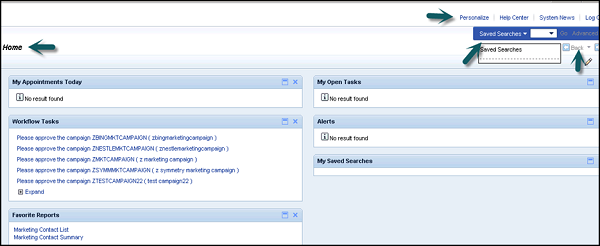
System Links in Header Area
The system links are displayed in the top right hand side area of the header section −
Personalize − This is used to perform personalization tasks.
Help Center − This is used to open online help for SAP CRM (may be rolespecific).
System News − This is used to launch a dialog box window with messages.
Log Off − This is used to log off the user.
-
Sequence of links − The sequence is as follows −
Personalize
Help Center
System News
Log Off
Work Area Title in Header Section
This is used to identify the object that consists the object type and attributes of object from attribute1attribute3. Rule for the work area title is −
<Object type> :< attribute 1>, <attribute 2>, <attribute 3>
Here the <Object type> defines the text description for the object type in the singular. It can also contain <transaction type> if several transactions are derived from the same object type and only differentiated by the transaction type name.
For example −
The work title for an overview page of an opportunity with Id = 8650 and Description = Sell Desktop and Prospect = TEST Cust will be presented as −
Opportunity: 8650, Sell Desktop, TEST Cust
Saved Searches
This area provides you direct access to a list of predefined search queries. The central search provides direct access to searches using one single search field.
Navigation Area
The Navigation bar allows you to navigate through the CRM applications and component functions that we use to access or enter the data quickly. You can also access each link in this Navigation area using keyboard shortcuts.
The most common links that are available in this Navigation area are as follows −
- Home
- Worklist
- Calendar
Other links that are available in the Navigation bar are user specific and varies as per the business role. These can include −
- Application links
- Quick create links
- Recent items
You can also divide the Navigation bar in the following four areas −
- First Level Navigation
- Second Level Navigation
- Create Areas and
- Recent Object Areas
It is also possible to collapse or expand the Navigation bar by using a dedicated button.
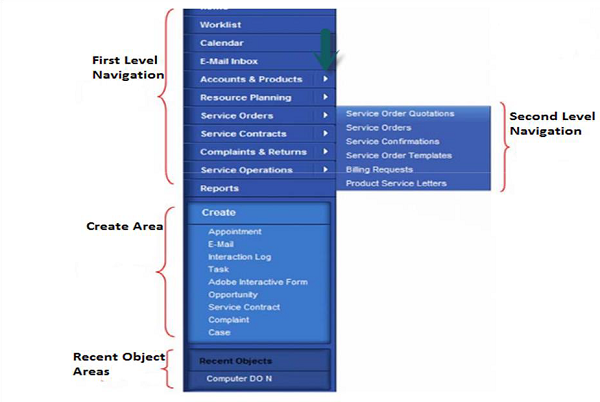
Any Navigation bar entries that are made below the Calendar and above the Reports is known as work centers.
You can define a work center as a page that is loaded to the work area when the user clicks the corresponding navigation bar entry.
Now if your text in entry exceeds the width of the Navigation bar then it inserts a line break that occurs automatically. It is recommended that you should use work centers with approximately 18-20 characters to avoid any line break.
Work Area
The work area is a place where changes happen with user actions and where the users works. This area contains work center groups, overview pages, email inbox, etc.
This work area consists of the following common pages −
- Home
- Work List
- Email inbox and calendar
Home Page
As per the requirement you can customize the home page of the WebClient. You can add CRM links for customization. The home page is the first page that appears when a SAP CRM user logs-in. It shows the most important information for the users daily business.
This can be information or links to access important information. Therefore, some content is dynamic like the My Appointment link changes daily and is dynamic, while other content is relatively static like favorite reports, etc.
The content of the home page can be customized as per the business requirement and depends on the user role.

Work List
This is used to display alerts, business transactions and alerts that are assigned or pending to the user through which you are logged in. It allows you to navigate to different transactions and applications using the work list.
Email Inbox and Calendar
This can be used to sync the user mailbox with CRM WebClient. A user can access the mailbox within the WebClient UI using the CRM Middleware settings. You can use Outlook or Lotus Notes to sync with CRM WebClient and different views are possible within the calendar page.
Overview Pages
The overview page is used to provide an overview of complete information regarding a single object like an account, campaign, etc. It provides you navigation links for a respective object. When you call the overview page for an object it appears like a read only page.
An Overview page consists of the following areas −
Work Area Title − This is used to identify the current object.
Work Area Toolbar − It contains all the functions that can be used on the respective object.
Details Assignment Block − This block defines the most important attributes of an object.
Assignment Blocks − This contains additional attributes for the object and the additional information assigned to this object.
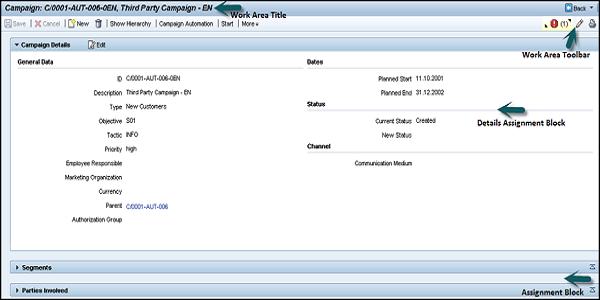
An assignment block can have the following three possible views −
- Form view
- Table view
- Tree view
An Assignment Block has the following two components −
Title Bar − First there is a title bar that contains a title which should help the user to identify the assigned information.

Content Area − The content area of assignment block shows the additional information in a table, a form, or a tree.
